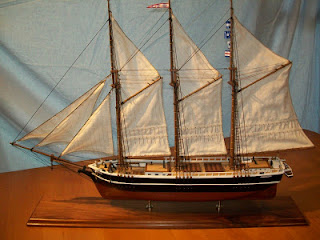 |
| JIM GOODWIN MODEL |
In The Story of the Methodist in the Port of Beaufort, 1941, Amy Muse wrote,
 "The Nellie B. Dey, Mr. Dey's fish boat, finally brought the victims in to the wharf at the foot of
"The Nellie B. Dey, Mr. Dey's fish boat, finally brought the victims in to the wharf at the foot of “'Miss Daisy' Hatsell tells of standing in the cold of the upper piazza of her home on Queen Street watching as the men were borne to the cemetery on improvised biers, and “Miss Lutie” Jones tells of the feeling of awe that came over her when as a child she ran in to the cemetery and saw so many graves open at the same time. None of the men were from Beaufort, but it was an incident that would have stirred any people and to a people as compassionate by nature as those in Beaufort, it left such an impression that voices are hushed to-day as the story is retold. A small compensation for the tragedy was the establishment of the Cape Lookout Life-Saving Station in 1887 which is said to have been a direct result of the event.”
_______________________
On Saturday, May 26, 2007, the following article was published
in The Courier Post, Cherry Hill, New Jersey:
in The Courier Post, Cherry Hill, New Jersey:
"Only One Survived Sinking of Jersey-built Schooner in 1886"
The coast off
The "New Jersey Patriot" newspaper of Bridgeton Jan. 16, 1874 , edition that a fine three-mast schooner was being built at the Blew and Phillips shipyard in Bridgeton
The Crissie Wright was launched July 11, 1874 , according to the "New Jersey Patriot," which described the schooner as a staunch and graceful vessel.
 My interest in the fate and history of the Crissie Wright is personal, coming from an entry in our family Bible that lists the death of my Great Grandfather Phillip H. Rickards on
My interest in the fate and history of the Crissie Wright is personal, coming from an entry in our family Bible that lists the death of my Great Grandfather Phillip H. Rickards on The Crissie Wright set sail from
Treacherous Weather
Capt. Clark decided not to risk the Diamond Shoals in the threatening weather -- high winds and a drastic drop in temperature. Capt. Clark ordered the ship to head for a safe harbor in Beaufort , N.C.
One sailor drowned in an attempt to get to shore, and another was knocked overboard and lost by the breaking of the mizzenmast. Days later, a body was found with a rope tied around his waist, with both hands missing, and his head scalped.
The Crissie Wright -- helpless on the west end of Shackleford Banks, where it lay broadside -- was breached by every incoming icy wave. Howling winds and snow and sleet covered the rigging and deck with ice, making footing most treacherous.
The crew of the Crissie Wright was without food or heat for three days and was unable to reach the mainland. They wrapped themselves in the main sail in an attempt to ward off the freezing gales.
Rescuers Thwarted
The residents of nearby Diamond City
From a newspaper clipping saved in our family Bible is a telegraph from Morehead City Jan. 11, 1886 , stating: "ONLY ONE SURVIVOR Six of Crew of Crissie Wright Drowned or Frozen To Death. The steamer Nellie B. Dey of Beaufort, reached her today, and Captain Dudley boarded her and brought off the bodies of the four frozen men. The sole survivor is named Charles Tayt of Buffalo
A Common Grave
 The frozen bodies were taken to Beaufort, and three shipmates were interred in a common grave in the Old Burying Grounds in Historic Beaufort. Capt. Clark's body was returned home to
The frozen bodies were taken to Beaufort, and three shipmates were interred in a common grave in the Old Burying Grounds in Historic Beaufort. Capt. Clark's body was returned home to
To this day, the wreck of the Crissie Wright has remained part of the legend and folklore of the town of Beaufort
Of the thousands of ships that have gone down off the coast, the Crissie Wright captured the imagination and hearts of the folks of Beaufort.
"Cold as the night the Crissie Wright came ashore" was a way natives of Beaufort once described extreme cold weather.
More Information Sought
In an attempt to uncover as much related history of the Crissie Wright as I could, I contacted the N.C. Underwater Archaeology Department, which forwarded all the information on file, including a copy of the official accident report.
The ship was valued at $20,000, and cargo was valued at $30,000 -- all a total loss, the report says. Capt. Thomas P. Clark, master of the vessel, was the only crew member named.
Dave Moore, curator of nautical archaeology at the North Carolina Maritime Museum
The name of the ship apparently came from the family of one of the investors.
While Capt. Clark was the principal owner, other investors were Bartlet and Shepherd, Jacob E. Ridgeway, M.A. Davis and Charles Wright.
In the "History of Berlin," Charles Wright is listed as a businessman, and his wife and daughter are both named Christine. Capt. Clark, a widower, was survived by his 15-year-old daughter, Sallie. Ironically, Charles Wright's son Walter Wright married Clark 's daughter Sallie. Christine Wright -- "Crissie" -- became Sallie's mother-in-law.
My Great Grandfather Phillip H. Rickards was born in Cedar Neck, Del.
C.G. "Rick" Rickards
This photograph was taken in 1933 by Rick Rickards' grandfather when he visited his father's (Phillip Rickards) Crissie Wright mass-grave site at the Old Burying Ground. Rick's grandmother is sitting on the steps. Below is an advertisement most likely picked up by Rick's grandfather.








